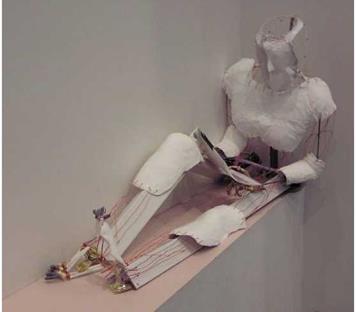Systems theory sprang from the origin of human factors engineering—a view primarily interested in looking at everything as a complex series of interrelated systems. Everything is, in a sense, a system, and all systems have inputs and outputs. An objective or goal that one might induce in design is to optimize the "fit" between one system and another—between one system and other systems—between humans and "machines" (i. e., between people and furniture, product design, etc.). In a sense, designers do not design furnishings, designers design systems—creating larger systems out of smaller subsystems—and we design systems to integrate within larger systems. Anything can be considered a system, including human beings, and each system is part of a larger system, while simultaneously being composed of a series of smaller subsystems.
Take a particular chair design, for example. How much weight does it have to support? What issues arise in terms of ingress and egress? How is it to function? How should it be made? How much does it cost? How durable is it? What is its intended environmental
![]() Systems Theory
Systems Theory
context? Who is going to use it? What is the age of the user? What is it going to go with? These are just a few of the many questions to consider in determining a base for judging the value of the design of the chair.
Designing and fabricating furniture is one way of learning about furniture design. Remember to note the successes and failures that occur from conception through the life of a piece. Inquiry is an active part of the process of design, and one makes observations and takes notes along the way. Successes and failures during the process are part of one’s research. Theories develop from designing, fabricating, and experiencing furniture, as well as through reading, writing, observing, and studying furniture.
The human body is a network of interrelated systems (nervous, skeletal, muscular, vascular, etc.). Similarly, furniture can be conceived of as a series of interrelated systems. In the 1960s and 1970s, it was popular to think about design as the management of systems. One did not design a chair or a table; one designed systems with which human and building systems interacted. Office furniture was known as systems furniture because of its integration of physical, structural, spatial, and electrical systems. Seating devices were referred to as human body support systems.
Systems theory grew out of human factors engineering and deconstructed the modernist use of the word function into an array of systematic relationships. In systems theory, the primary objective of design was to optimize the fit between humans and machines. Systems theory contributed to a paradigm shift in the way people thought about design in general and furniture design in particular.
Mapping and modeling the human body while standing, leaning, squatting, or sitting can be a good exercise to help designers understand body posture and body space (Figures 5.3 and 5.4). Human factors specialists rely on scientific methods and an enormous amount of research to better understand aspects of measure, posture, and physiology. However, the paradigm shift toward this line of research never took root within the design community,
|
|
|
|
and systems theory lost its momentum by the mid-1980s to more cultural, humanistic, and phenomenological considerations. The awkward terminology contributed to its demise, but the rigorous and scientifically based research influenced the modern office workplace.




